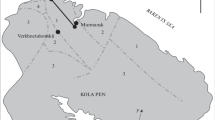Abstract
As an important component of the cryosphere, sea ice is very sensitive to climate change. The study of sea ice physics needs accurate sea ice thickness. This paper presents an electromagnetic induction (EM) technique which can be used to measure the sea ice thickness distribution efficiently and its successful application in the Antarctic Neila Fjord. Based on the electrical properties of sea ice and seawater and the application of electromagnetic field theory, this technique can accurately detect the distance between the EM instrument and the ice/water interface to measure the sea ice thickness. Analyzing the apparent conductivity data obtained by the electromagnetic induction technique and drill-hole measurements at same location allows the construction of a transform equation for the apparent conductivity and sea ice thickness. The verification of the calculated sea ice thickness using this equation indicates that the electromagnetic induction technique is able to determine reliable sea ice thickness with an average relative error of only 5.5%. The ice thickness profi les show the sea ice distribution in Neila Fjord is basically level with a thickness of 0.8–1.4 m.
Similar content being viewed by others
References
Barry, R. G., Serreze M. C., Maslanik J. A., and Preller, R. H., 1993, The Arctic sea ice-climate system: observations and modeling: Reviews of Geophysics, 31(4), 397–422.
Dickson, B., 1999, All change in the Arctic Ocean: Nature, 397, 389–391.
Guo, F. L., Zhao, R. Y., and Wang, W. B., 2000, Application of passive microwave remote sensing to sea ice thickness measurement: Journal of Remote Sensing (in Chinese), 4(2), 112–117.
Haas, C., 1998, Evaluation of ship-based electromagnetic-inductive thickness measurements of summer sea ice in the Bellingshausen and Amundsen seas, Antarctica: Cold Regions Science and Technology, 27, 1–16.
James, B. A., Sun, X. L., Riris, H., Sirota, J. M., Mcgarry, J. F., Palm, S., Yi, D. H., and Liiva, P., 2005, Geoscience laser altimeter system (GLAS) on the ICESat mission: On-orbit measurement performance: Geophysical Research Letters, 32, L21–S02.
James, E. R., Worby, P. A., Vrbancich, J., and Angus, I. S., 2003, Shipborne electromagnetic measurements of Antarctic sea-ice thickness: Geophysics, 68(5), 1537–1546.
Johannesen, O. M., Shalina, E. V., and Miles, M. W., 1999, Satellite evidence for an Arctic sea ice cover in transform: Science, 286, 1937–1939.
Kaufman, A. A., and Keller, G.V., 1983, Frequency and transient soundings: Elsevier Science Publishing Co., Inc., New York, 490–521.
Kovacs, A., Holladay, J. S., and Bergeron, C. J., 1995, The footprint/altitude ratio for helicopter electromagnetic sounding of sea-ice thickness: Comparison of theoretical and field estimates: Geophysics, 60, 374–380.
Kunio, S., Tateyama, K., Takatsuka, T., Kawamura, T., and Uto, S., 2006, Ship-borne electromagnetic induction sounding of sea ice thickness in the Arctic during summer 2003: Polar Meteorol. Glaciol. 20, 53–61.
Liu, G., and Becker, A., 1990, Two-dimensional mapping of sea ice keels with airborne electromagnetics: Geophysics, 55, 239–248.
Marcel, N., Haas, C., and Bareiss, J., 2003, Observations of superimposed ice formation at melt-onset on fast ice on Kongsfjorden, Svalbard: Physics and Chemistry of the Earth, 28, 1241–1248.
Paul, G. F., and Pete, S., and Andrew, S. B., 2003, Autonomous underwater vehicles: future platforms for fisheries acoustics: Ices Journal of Marine Science, 60, 684–691.
Strass, V. H., 1998, Measuring sea ice draft and coverage with moored upward looking sonars: Deep-Sea Research I, 45, 795–818.
Sun, B., Wen, J. H., He, M. B., Kang, J. C., Luo, Y. Z., and Li, Y. S., 2002, Sea ice thickness measurements and its underside morphology analysis using radar penetration in the Arctic Ocean: Science in China (Series D), 32(11), 951–958.
Wait, J. R., 1982, Geo-electromagnetism: Academic Press, New York, 1–23.
Wu, H. D., Bai, S., and Zhang, Z. H., 1998, Numerical simulation for dynamical processes of sea ice: Acta Oceanologica Sinica (in Chinese), 120(2), 1–13.
Xie, S. M., Bao, C. L., and Hao, C. J., 1995, Interaction between sea ice of the Antarctic and Arctic: Chinese Science Bulletin (in Chinese), 40(7), 632–635.
Author information
Authors and Affiliations
Additional information
This work was supported by National Natural Science Foundation of China (Grant No. 40476005 and 40233032), the Ministry of Science and Technology, China (Grant No. 2005DIB3J114), and the “863 Project” (Grant No. 2006AA04Z206 and 2006AA09Z152).
Guo Jingxue, graduated from the College of GeoExploration Science and Technology of Jilin University in 2002 with a bachelor’s degree. Now he is a PhD candidate in the College of GeoExploration Science and Technology of Jilin University with a major in applied geophysics. He is mainly engaged in research on sea ice and climate change, specializing in measuring the physical characteristics of sea ice with geophysical methods.
Rights and permissions
About this article
Cite this article
Jingxue, G., Bo, S. & Gang, T. The application of electromagnetic-induction on the measurement of sea ice thickness in the Antarctic. Appl. Geophys. 4, 214–220 (2007). https://doi.org/10.1007/s11770-007-0024-9
Received:
Revised:
Published:
Issue Date:
DOI: https://doi.org/10.1007/s11770-007-0024-9



